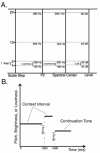Expectations for melodic contours transcend pitch
- PMID: 25365571
- PMCID: PMC4605576
- DOI: 10.1037/a0038291
Expectations for melodic contours transcend pitch
Abstract
The question of what makes a good melody has interested composers, music theorists, and psychologists alike. Many of the observed principles of good "melodic continuation" involve melodic contour-the pattern of rising and falling pitch within a sequence. Previous work has shown that contour perception can extend beyond pitch to other auditory dimensions, such as brightness and loudness. Here, we show that the generalization of contour perception to nontraditional dimensions also extends to melodic expectations. In the first experiment, subjective ratings for 3-tone sequences that vary in brightness or loudness conformed to the same general contour-based expectations as pitch sequences. In the second experiment, we modified the sequence of melody presentation such that melodies with the same beginning were blocked together. This change produced substantively different results, but the patterns of ratings remained similar across the 3 auditory dimensions. Taken together, these results suggest that (a) certain well-known principles of melodic expectation (such as the expectation for a reversal following a skip) are dependent on long-term context, and (b) these expectations are not unique to the dimension of pitch and may instead reflect more general principles of perceptual organization.
PsycINFO Database Record (c) 2014 APA, all rights reserved.
Figures





References
-
- Balch W. The role of symmetry in the good continuation ratings of two-part tonal melodies. Perception & Psychophysics. 1981;29(I):47–55. - PubMed
-
- Bolles RC. Reinforcement, expectancy, and learning. Psychological Review. 1972;79(5):394–409. doi:10.1037/h0033120.
-
- Bregman A. Auditory Scene Analysis: The Perceptual Organization of Sound. MIT Press; Cambridge, MA: 1994.
-
- Carlsen JC. Some factors which influence melodic expectancy. Psychomusicology: Music, Mind & Brain. 1981;1:12–29.
Publication types
MeSH terms
Grants and funding
LinkOut - more resources
Full Text Sources
Other Literature Sources

